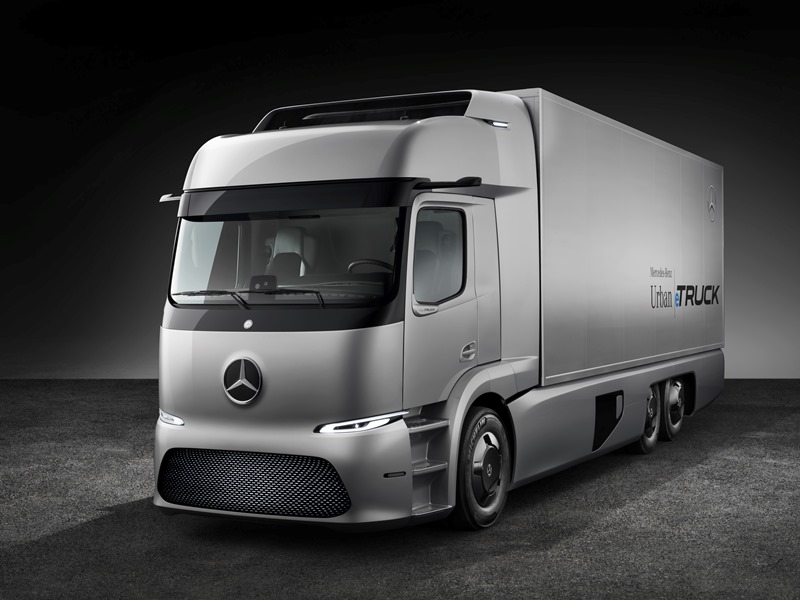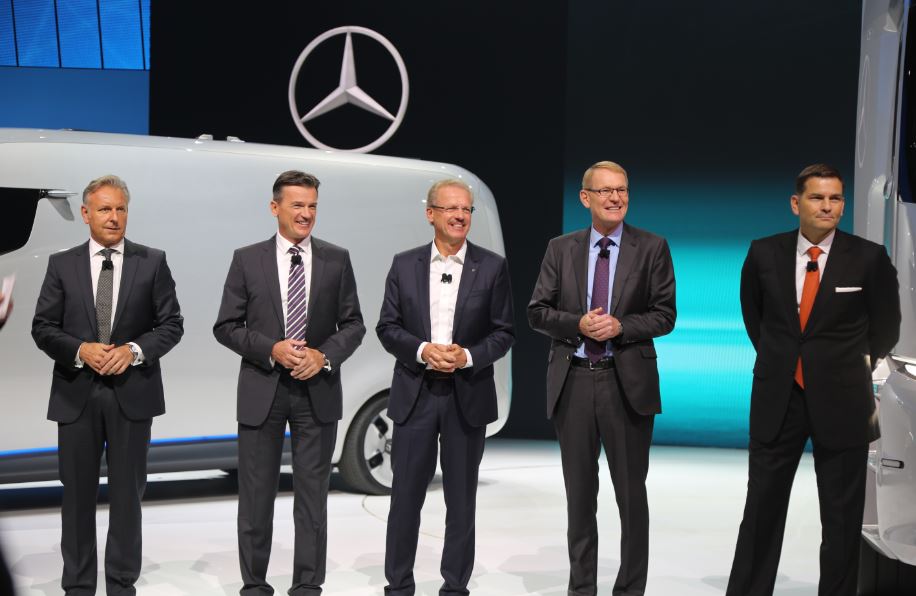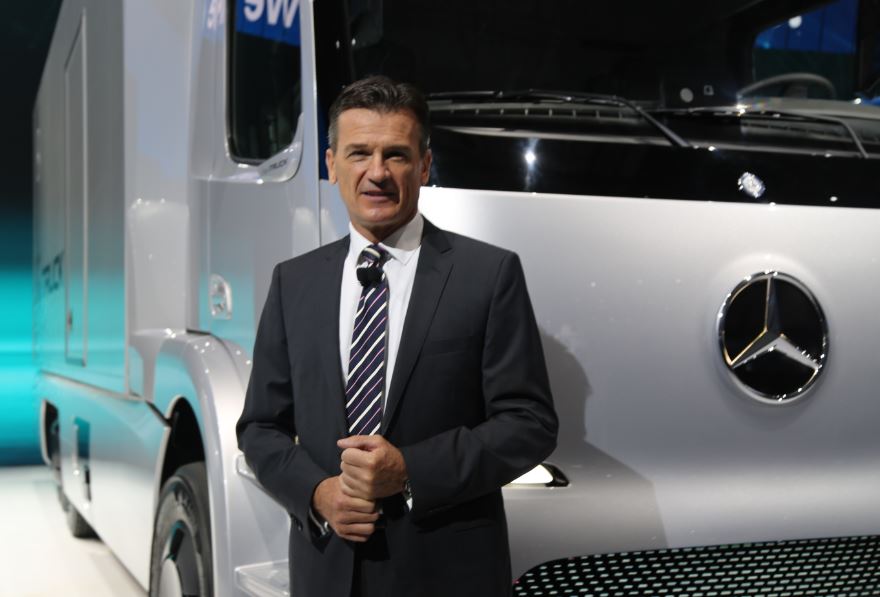World premiere: the all-electric and networked Mercedes-Benz Urban eTruck
At this year’s IAA International Commercial Vehicle Show the focus is on the megatrends of the future, digitalisation and e-mobility. The key to sustainable and efficient logistics of the future is called connectivity. Logistics rely on a network of players, including trucks, manufacturers, customers, hauliers, infrastructure, other vehicles, workshops, bodybuilders and many more. Connectivity and the intelligent networking of trucks are now raising the haulage sector to a whole new level.

Mercedes-Benz Trucks is raising the bar even further when it comes to connectivity. While the breakdown-free truck might have seemed a long way off at the beginning of the year, Mercedes-Benz Trucks are taking great strides towards this vision with the revolutionary Uptime service product. The new FleetBoard store for apps, which makes its debut at the IAA, provides useful apps made by, and for, the transport sector. FleetBoard also offers all Mercedes-Benz Trucks customers a simple, fast and free route to connectivity. This is made possible by the new FleetBoard Manager app.
Mercedes-Benz Trucks is linking the two megatrends digitalisation and e-mobility in the Urban eTruck. The vehicle is a spectacular vision of the networked and all-electric distribution truck of tomorrow. Fuso’s eCanter
is the third generation of the world’s first fully electric-powered light commercial vehicle and is the first small-scale production run of electric Fuso trucks.
The latest generation of the Mercedes-Benz OM 470 engine offers improved performance and greater efficiency. Mercedes-Benz Trucks has approved the use of alternative fuels in the latest OM 470 and OM 471 engines, which are designed to use such fuels as standard.
This year, Mercedes-Benz is also getting closer to the goal of accident-free driving. Active Brake Assist 4 is the first system of its type in the world to warn the driver of imminent collisions with moving pedestrians and simultaneously automatically initiate partial braking. Sideguard Assist with pedestrian detection will also be launched to market as the first assistance system that protects pedestrians and cyclists when trucks are turning. In short: Daimler Trucks is extending its lead as a pioneer in safety, economy and truck connectivity.
The Urban eTruck illustrates the fascinating possibilities of connectivity, electric drive systems, future display and control technologies, telematics, and a largely self-sufficient power supply. The Mercedes-Benz Urban eTruck defines the latest developments in all-electric vehicles in the heavy short-radius distribution sector. The triple-axle vehicle with a permissible gross weight of 26.0 t produces zero local emissions and runs silently, yet it is equal to a truck with an internal combustion engine in terms of load and performance, and, thanks to its innovative power supply, it is also economical.
Electric truck with the performance of a diesel engine
The Urban eTruck holds its own against similar internal combustion engine-powered trucks in every respect, even its weight. The additional weight stands at only 1700 kg. As the EU Commission is in favour of increasing the permissible gross vehicle weight of trucks with alternative drives by a maximum of 1.0 t, this will more or less cancel out the weight disadvantage of the electric drive.
The outstanding features of the Urban eTruck include its drive with electrically powered rear axle and electric motors directly adjacent to the wheel hubs. Its maximum output is 2 x 125 kW, while torque is 2 x 500 Nm. The standard version of the axle has already proven itself in buses. The battery capacity of the Urban eTruck has a modular design. The basic arrangement is a battery pack consisting of lithium-ion batteries with a total capacity of 212 kWh. This results in a range of up to 200 km, normally enough for a typical day’s delivery round.
Connectivity meets e-mobility: intelligent energy management in the Mercedes-Benz Urban eTruck
The Urban eTruck uses the possibilities opened up by connectivity to create a seamlessly interconnected system that incorporates range and load management, vehicle information and peripheral data. The modular construction of the batteries is the first step towards perfecting the interaction between drive control and power supply management to maximise performance and range in short-radius distribution. The additions of Predictive Charge Management, proactive Predictive Powertrain Control cruise control and FleetBoard for urban distribution make the Urban eTruck suitable for everyday use.
The innovative FleetBoard for urban distribution telematics service is the first to connect the telematics system with the drive control. It starts with the scheduling, instead of the conventional fixed delivery runs there is a flexible system. It ensures that all the planned haulage work can be completed by the vehicle fleet without overextending or underutilising the range of the trucks. The variables used include the pallet spaces in the trucks, the weight, the range and the driving times. Virtual monitoring intervenes if unforeseen events force the truck to the limits of its range.
The driver is assisted by a revolutionary display and operation system, with two displays taking the place of standard instruments. The innovative central display shows the driver a wide range of information in an easily assimilated form. The focus is on detailed data and facts about the route, so the driver can see the bends on the road and any accelerating or braking manoeuvres ahead.
The Urban eTruck can operate in three different modes, which optimise the way in which it is driven and the use of the energy available. On a standard journey, the Urban eTruck is set to ‘auto’. It automatically adapts the ‘auto’, ‘agile’ and ‘eco’ settings to conditions within a certain target range. For special cases there is a power mode called ‘agile’, and for maximum range there is an ‘eco’ mode.
A tablet provides the driver with additional information about the trip, as well as continually updated and precise details on range and batteries. These are presented on a local map with a clever graphic known as the ‘range potato’ and a target range. The calculations are based on the driving strategy, the three-dimensional map and the trip planning.
Competitive total costs with smart energy services
The power supply, the energy tariffs and the correct charging strategy are important factors for the overall economy of electric trucks, and Daimler has developed a solution for this, too. With smart energy services, the OEM, determines the most economical solution for every application. Depending on individual circumstances, stationary battery storage units from Mercedes-Benz Energy GmbH can further improve economic efficiency and enable quick recharging without overloading the power supply. The storage units consist of lithium-ion batteries, and the capacity can be adapted individually to the requirements of the fleet.
The most straightforward way of supplying power to electric vehicles is also the most expensive. The energy bill will be lower with regulated charging and, where suitable, with the addition of a stationery battery storage unit. Whether a storage unit will improve economic efficiency further depends on the circumstances in each case, in particular the energy tariff and the vehicles’ usage. A unit of this kind can be charged on a continual basis when electricity costs are at its lowest. The batteries for the truck fleet can then be charged as and when required. This means lower costs and better availability. Irrespective of whether a battery storage unit makes sense in each case, the costs of an electric vehicle in combination with smart energy solutions can be considerably lower than those of a conventional diesel truck, despite the higher purchasing price and the additional investment in the storage capacity.
Innovative design with flowing lines
The styling of the Urban eTruck is as innovative as its electric drive. It embodies the design philosophy of the Mercedes-Benz brand, which focuses on sensual purity, an expression that applies perfectly to the Urban eTruck. The contours of the driver’s cab are sleek and fluid with minimal detailing and no visible joints.
Across the roof, a three-dimensional spoiler connects the cab with the body of the truck. It has a wide vent at the front, which acts as the air inlet for the cooling unit concealed behind the spoiler, as used in the food industry, for example. Just like the roof spoiler, the aerodynamic skirting panels on the side of the cab fit almost flush with the body. The windscreen has been extended downwards. The mirror cams, that replace the conventional outside mirrors, are a distinctive feature on the truck.
The conventional air inlet has been omitted from the Urban eTruck because of the electric drive. Instead, a Black Panel grille is the branding element that connects the truck with its environment. It is transparent and back-lit by high-resolution LEDs. A number of different visual scenarios are conceivable: the LEDs can be used to recreate the signature Mercedes-Benz diamond radiator grille, to indicate the operating status of the truck or to show the charge level of the batteries.
Overall, the Urban eTruck represents the polarity between ‘hot & cool’ that is characteristic of Mercedes-Benz design. The sensual contouring of the lines is ‘hot’ and provides an exciting contrast to the highly technical ‘cool’ design features such as the embedded lighting, mirror cams and Black Panel grille.

